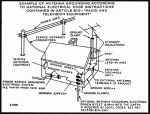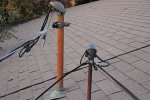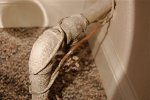I'm going to be mounting a 10 foot mast on the roof of the house. I have read about all I can read about grounding in a 24 hour period. I understand how to ground the mast, lightning arrestors, cable size, etc.
However it is my understanding that I also need to bond the antenna system to the house power grounding system. There is no way for me to do that outdoors as far as I can tell. My power comes from overhead wires to a service entrance on the roof, then into the house. The only thing visible on the outside is the meter, and even there all I can see is the glass cover. In other words, there is no metal to connect any ground cable to on the outside of the home.
On the inside however, the main electrical ground is a heavy gauge copper wire that runs from the panel upstairs to the main cold water pipe in the basement. So, is that where I should connect the antenna system to the house power grounding system using some 6 AWG or larger, or am I not getting this right? Any help is appreciated.
However it is my understanding that I also need to bond the antenna system to the house power grounding system. There is no way for me to do that outdoors as far as I can tell. My power comes from overhead wires to a service entrance on the roof, then into the house. The only thing visible on the outside is the meter, and even there all I can see is the glass cover. In other words, there is no metal to connect any ground cable to on the outside of the home.
On the inside however, the main electrical ground is a heavy gauge copper wire that runs from the panel upstairs to the main cold water pipe in the basement. So, is that where I should connect the antenna system to the house power grounding system using some 6 AWG or larger, or am I not getting this right? Any help is appreciated.






